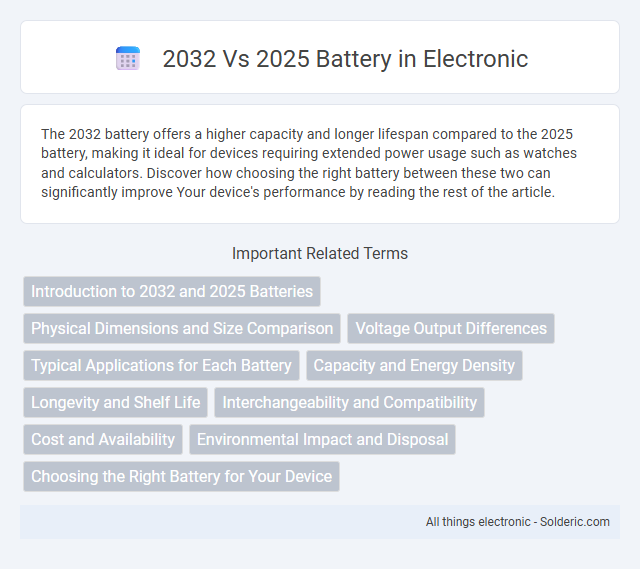The 2032 battery offers a higher capacity and longer lifespan compared to the 2025 battery, making it ideal for devices requiring extended power usage such as watches and calculators. Discover how choosing the right battery between these two can significantly improve Your device's performance by reading the rest of the article.
Comparison Table
| Feature | Battery 2032 | Battery 2025 |
|---|---|---|
| Dimensions (Diameter x Thickness) | 20mm x 3.2mm | 20mm x 2.5mm |
| Voltage | 3V | 3V |
| Capacity | Approx. 225-240 mAh | Approx. 150-170 mAh |
| Typical Use | Watches, Calculators, Medical Devices | Remote Controls, Watches, Small Electronics |
| Weight | ~3 grams | ~2 grams |
| Price Range | Moderate | Lower |
Introduction to 2032 and 2025 Batteries
2032 and 2025 batteries are both lithium coin cells commonly used in small electronic devices such as watches, calculators, and key fobs. The 2032 battery has a diameter of 20mm and a thickness of 3.2mm, offering higher capacity and longer life compared to the 2025, which measures 20mm in diameter but is thinner at 2.5mm. Understanding these size and capacity differences helps you choose the right battery for your device's power needs.
Physical Dimensions and Size Comparison
The 2032 battery measures 20mm in diameter and 3.2mm in thickness, providing a slightly larger size compared to the 2025 battery, which is 20mm in diameter but only 2.5mm thick. This difference in thickness can impact compatibility with devices requiring precise battery dimensions. Your choice between these batteries should consider the physical size constraints of your device to ensure proper fit and optimal performance.
Voltage Output Differences
The 2032 battery typically provides a nominal voltage of 3 volts, compared to the 2025 battery's slightly lower voltage output of around 2.5 volts. This difference in voltage output can impact the performance and compatibility of your electronic devices, especially those requiring precise power levels. Choosing the correct battery ensures optimal functionality and prevents potential damage caused by voltage mismatches.
Typical Applications for Each Battery
The 2032 battery is commonly used in small electronic devices such as wristwatches, calculators, and keyless remote entry systems, providing reliable power in compact form factors. In contrast, the 2025 battery finds typical applications in devices requiring higher capacity but similar size, including car key fobs, fitness trackers, and medical devices like glucometers. Both batteries serve as popular choices for portable, low-drain electronics, with the 2025 variant favored when longer battery life is essential.
Capacity and Energy Density
The 2032 battery typically offers a capacity around 220-240 mAh, surpassing the 2025 battery's capacity of approximately 150-170 mAh, making it more suitable for devices requiring longer-lasting power. Energy density in the 2032 battery is also higher due to its larger volume and optimized chemical composition, enabling more efficient energy storage per unit weight. These characteristics make the 2032 preferable for high-drain applications compared to the smaller and lower capacity 2025 battery.
Longevity and Shelf Life
2032 batteries typically offer a longer shelf life of up to 10 years due to their stable lithium chemistry, making them ideal for low-drain devices requiring prolonged storage. In contrast, 2025 batteries usually have a slightly shorter shelf life, around 5 to 7 years, fitting applications with moderate power demands and regular replacement cycles. Longevity in actual use for both types depends on the device's power consumption, but 2032 batteries generally maintain voltage longer, enhancing performance in extended-use scenarios.
Interchangeability and Compatibility
2032 and 2025 batteries differ primarily in thickness, with the 2032 being 3.2mm and the 2025 measuring 2.5mm, affecting their interchangeability in electronic devices. While both share the same diameter (20mm) and voltage (3V), using a 2025 in place of a 2032 may result in shorter battery life due to reduced capacity, but physical fit may be problematic if space is precise. Ensuring compatibility with your device involves checking the required battery size and considering that substituting one for the other can impact performance and operational time.
Cost and Availability
The 2032 battery generally costs more than the 2025 battery due to its higher energy capacity and longer lifespan, making it a preferred choice for devices requiring extended usage. Availability of the 2032 battery is widespread across retail and online stores, though the 2025 battery remains more common in budget-sensitive applications. Your choice between the two should consider both cost constraints and the specific power needs of your device.
Environmental Impact and Disposal
The 2032 battery generally contains more energy-dense materials compared to the 2025 battery, leading to a potentially higher environmental impact if not disposed of properly. Proper recycling of lithium and other heavy metals in both batteries is crucial to prevent soil and water contamination. Your choice to recycle these batteries responsibly helps reduce hazardous waste and supports sustainable resource recovery.
Choosing the Right Battery for Your Device
Choosing the right battery for your device involves understanding the key differences between a 2032 and a 2025 battery, primarily their thickness and capacity. The 2032 battery is thicker at 3.2mm and offers a higher capacity (typically 220-240mAh) compared to the thinner 2.5mm 2025 battery with lower capacity (about 150-170mAh). Your device's specifications and power requirements determine whether the longer-lasting 2032 or the slimmer 2025 provides optimal performance and fit.
2032 vs 2025 battery Infographic

 solderic.com
solderic.com